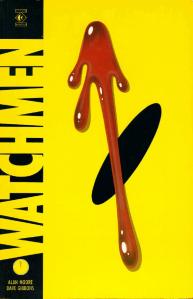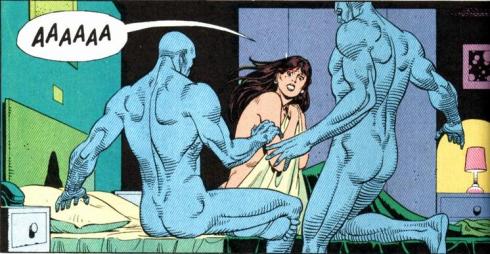Me: I’ve started Watchmen, and it’s great.
Friend: The movie was so. very. desperate. I felt a little molested when I left. Granted, I watched it in IMAX, so the 3-story blue schlong was part of it.
Friend: Literally, it was a dick three stories tall.
I think we can all agree that there was absolutely no other way to begin this review.
Finishing Watchmen is a small victory in my quest to keep a mildly ambitious list of 2013 reading resolutions, which also include spending a little time with biographies, poetry and historical nonfiction. (Let’s all pause for a moment to be collectively not surprised that I started with the graphic novel.) Watchmen is also arguably the most famous graphic novel of all time, an accolade I’m basing on the fact that it was recommended to me by no fewer than three people, and has a substantial number of glowing blurbs on its back cover. If I was going to read a graphic novel, this seemed the obvious place to start.
At the risk of provoking a nerd outcry (and in the interest of explaining the novel to those who haven’t read it) Watchmen is sort of like a really dark The Incredibles. It takes place in a fictional 1985, eight years after the Keene Act outlawed “costumed adventuring” by vigilantes not in the employ of the U.S. government. The novel opens with the death of the Comedian, a former member of both the Minutemen (a 1940s group of masked avengers) and the Crimebusters (the Minutemen’s much more horribly named successors). The Comedian’s death, a probable homicide, leads us to Rorschach (another former Crimebuster, and our protagonist of sorts), who is convinced that someone is purposefully killing masks. The rest of the novel is a whodunit for this mysterious killer, as well as a biography-slash-memoir of the masked avengers, and a fairly timeless commentary on the ills of society and the threat of nuclear destruction (despite being fictional, this 1985 still includes a Soviet war in Afghanistan). Although it isn’t particularly hard to follow, it would be fair to say that Watchmen has a lot going on.
Throughout the novel, we meet various other crime-fighters, including other members of the Minutemen and Crimebusters. There’s Captain Metropolis, and two iterations of Nite Owl (older and younger). There’s Silk Spectre I and II (mother and daughter) and Ozymandias, and Hooded Justice, whose costume is hilariously literal. And perhaps most importantly, there’s Dr. Manhattan, a physicist turned all-powerful blue man, who basically resurrected himself after being disintegrated in an Instrinsic Field Subtractor in 1959. An introspective kind of guy—by which I mean lacking in the skills of social interaction—Dr. Manhattan is now considered America’s preeminent weapon of mass destruction, having intervened in Vietnam and kept the Russians at bay during the Cold War. I should also note: the three-story dong is his.
There are even more characters in Watchmen, including a modern-day Greek chorus of outside commentators: detectives, civilians and (my favorite) a classic New York City newsstand owner. There’s also a lot more plot and back story than I have the time or you have the energy to go into. Honestly, I’ll be happy if I didn’t lose you at Instrinsic Field Subtractor.
But despite its inherent geekery (superheroes, physics experiments gone wrong, nuclear war; there’s even a comic book within the comic book) Watchmen isn’t inaccessible, and doesn’t require any particular affinity for comics or science fiction. It is ultimately just a story—a mystery, a character study and even a bit of a romance—and one that frankly would still resonate if it were released for the first time today. It’s engrossing and creative (traditional comic strip panels are broken up by newspaper articles, book excerpts and other documents) and overall just a really enjoyable way to spend a week.
I realize of course that the Watchmen style of graphic novelry, which is to say the traditional comic book vibe, doesn’t apply across the board, and my next GN contenders—From Hell and Box Office Poison—are much lighter on dialogue bubbles and intricate coloring. But for its part, Watchmen is truly beautiful, and a friend’s recommendation to take my time with it was well-founded. Hidden among the basic information in each panel—a character and what they’re saying—are hints and nudges of broader context: headlines on newspapers, signs on walls, etc. (The title of this post is inspired by graffiti that appears throughout the novel.) It was in these details that I found myself most impressed with Watchmen, and I suppose the entire genre. There’s no room in graphic novels for descriptive language, and so the obstacle of creating a thoroughly developed place and time—not only in each scene but in the story as a whole—falls to the artist. It’s a formidable task, and unlike regular books—where an author can probably assume readers aren’t skipping lines of text—one an illustrator may never be entirely sure is appreciated.
If you’ve never read a graphic novel, I highly recommend Watchmen (and if you have read a graphic novel but you’ve never read Watchmen, I highly recommend Watchmen). It’s not hard to see why the book was so well received, or why it was ultimately adopted into a movie, or why the movie (however long and complex it must have felt to the Watchmen virgin) hewed so closely to many of the graphic novel’s exact scenes, frame by frame. If I had to sum this novel up in one sentence (I often envisage a scenario where I am held at gunpoint and asked to summarize novels in single sentences), it would be this: “The Incredibles meets X-Men meets V for Vendetta, plus a giant blue penis.”
🏆🏆🏆🏆
TITLE: Watchmen
—————————————-
AUTHOR: Alan Moore (Author), Dave Gibbons (Illustrator)
—————————————-
PAGES: 416
—————————————-
ALSO WROTE: V for Vendetta, From Hell (Moore)
—————————————-
SORTA LIKE: The Incredibles meets X-Men meets V for Vendetta
—————————————-
FIRST LINE: “Rorshach’s Journal. October 12th, 1985: Dog carcass in alley this morning, tire tread on burst stomach. This city is afraid of me. I have seen it’s true face.”



Oddly enough, Brad Bird (director of “The Incredibles”) listed “Watchman” as one of his primary influences for the movie. So we nerds shall allow the analogy. NYAAAIGN!
Watchmen is THE graphic novel to read, methinks. It merits multiple readings, because it is rich, and dense, and just builds a world of its own.